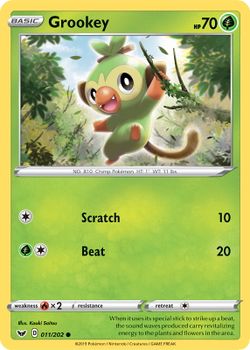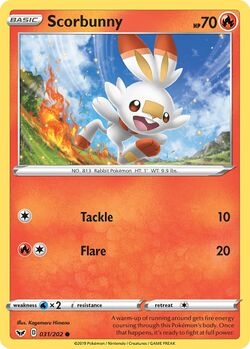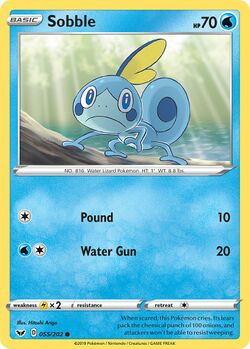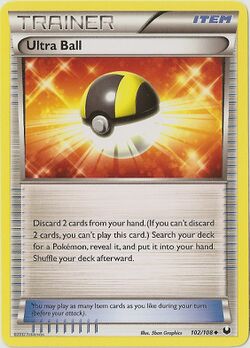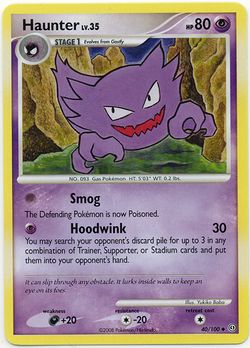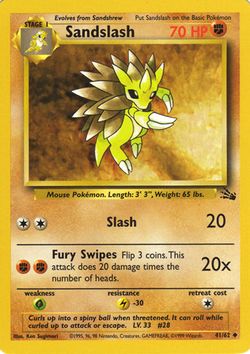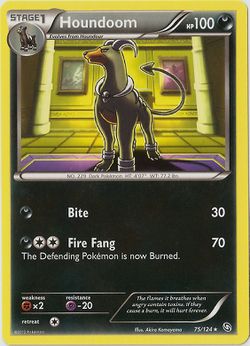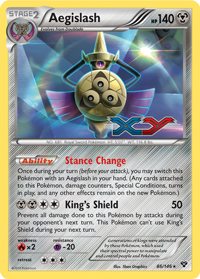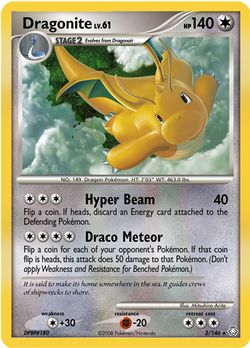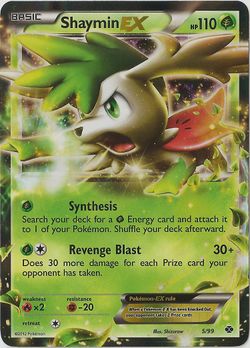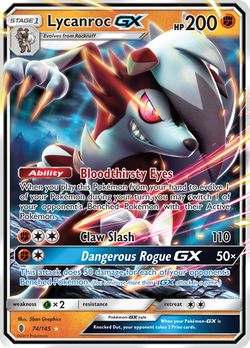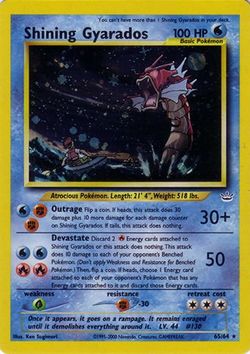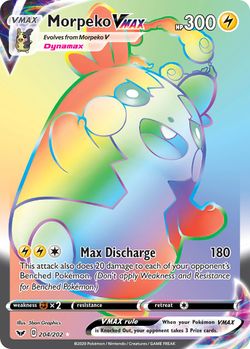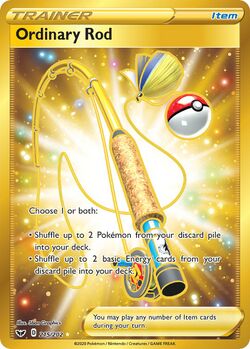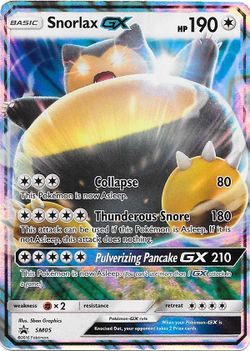From Bulbapedia, the community-driven Pokémon encyclopedia.
- This article is about the a concept in the Pokémon Trading Card Game. For a related concept in the core series video games, see List of Pokémon by availability.
In the Pokémon Trading Card Game, the rarity of a particular card (also known as the pull ratio) describes how difficult it is to obtain that particular card within each expansion. Though rarity typically correlates to the actual frequency at which a card is found in official Booster packs, some cards can be uncharacteristically common or rare for their official rarity.
There are three main rarities, represented on each card by a symbol printed at the bottom of each card: Common ( ), Uncommon (
), Uncommon ( ) and Rare (
) and Rare ( ). Some of the more exclusive Rare cards are known as Ultra Rare (
). Some of the more exclusive Rare cards are known as Ultra Rare ( ). Starting from ブラックコレクション Black Collection and ホワイトコレクション White Collection, Japanese releases, rather than using symbols, use bolded letters to denote rarity; for example,
). Starting from ブラックコレクション Black Collection and ホワイトコレクション White Collection, Japanese releases, rather than using symbols, use bolded letters to denote rarity; for example,  ,
,  ,
,  and
and  . Each non-promotional card released in an expansion pack has a set rarity. The rarity of a card may vary between Japanese and other-language releases; that is, a card which is Common (
. Each non-promotional card released in an expansion pack has a set rarity. The rarity of a card may vary between Japanese and other-language releases; that is, a card which is Common ( ) in the Japanese release may be Uncommon (
) in the Japanese release may be Uncommon ( ) in the English-language release (for example, Sudowoodo (Sword & Shield 100)).
) in the English-language release (for example, Sudowoodo (Sword & Shield 100)).
Every English-language Booster pack is guaranteed to contain at least 1 Rare ( ) card and generally 3 Uncommon (
) card and generally 3 Uncommon ( ) cards; the remainder will usually be Common (
) cards; the remainder will usually be Common ( ). Starting from the Legendary Collection expansion, each Booster pack is also guaranteed to contain 1 Reverse Holofoil card, which is a card of any Rarity with Holofoil printing on the background of the card but not on the image of the Pokémon, Item or Supporter. Energy cards do not have a rarity.
). Starting from the Legendary Collection expansion, each Booster pack is also guaranteed to contain 1 Reverse Holofoil card, which is a card of any Rarity with Holofoil printing on the background of the card but not on the image of the Pokémon, Item or Supporter. Energy cards do not have a rarity.
Standard rarity
Common
Common cards are marked with a circle ( ) and usually consist of basic, unevolved Pokémon. Most English Booster packs contain four to five Common cards. Common cards can also come in a Reverse Holofoil print.
) and usually consist of basic, unevolved Pokémon. Most English Booster packs contain four to five Common cards. Common cards can also come in a Reverse Holofoil print.
Uncommon
Uncommon cards are marked with a diamond ( ) and can consist of both evolved and unevolved Pokémon. The vast majority of Trainer cards are also at this rarity. Most English Booster packs contain three Uncommon cards. Uncommon cards can also come in a Reverse Holofoil print.
) and can consist of both evolved and unevolved Pokémon. The vast majority of Trainer cards are also at this rarity. Most English Booster packs contain three Uncommon cards. Uncommon cards can also come in a Reverse Holofoil print.
| Examples of Uncommon cards
|
|
|
|
|
Rare
Rare cards are marked with a star ( ) and usually consist of evolved and Legendary Pokémon. Most English Booster packs contain at least one guaranteed Rare card. Rare cards can also come in a Reverse Holofoil print. If a Booster pack contains a Reverse Holofoil Rare card, this is in addition to the guaranteed Rare card.
) and usually consist of evolved and Legendary Pokémon. Most English Booster packs contain at least one guaranteed Rare card. Rare cards can also come in a Reverse Holofoil print. If a Booster pack contains a Reverse Holofoil Rare card, this is in addition to the guaranteed Rare card.
The guaranteed Rare card may come in one of four sub-classifications of Rare card:
- Regular Rare, which are marked with
 but do not have any holofoil design
but do not have any holofoil design
- Holofoil Rare, which are marked with
 and also have a Holofoil design on the card art
and also have a Holofoil design on the card art
- Ultra Rare, which are marked with
 and are typically associated with a unique card classification or mechanic such as Pokémon V
and are typically associated with a unique card classification or mechanic such as Pokémon V
- Secret Rare, which are cards with set numbers outside the printed size of the set (for example, a card numbered 101/100), marked with
 , and have a unique artwork scheme such as a Rainbow Holofoil print.
, and have a unique artwork scheme such as a Rainbow Holofoil print.
Holofoil Rare
- Main article: Holofoil card
A small amount of rare cards within each expansion are available as both Regular Rare and Holofoil Rare. These cards have a Holofoil pattern on the card art and are marked with  . Cards which are available as either Regular Rare or Holofoil Rare are labelled with
. Cards which are available as either Regular Rare or Holofoil Rare are labelled with  on Bulbapedia. Holofoil Rare cards are rarer than regular Rare cards; a Holofoil Rare is not guaranteed in English Booster packs.
on Bulbapedia. Holofoil Rare cards are rarer than regular Rare cards; a Holofoil Rare is not guaranteed in English Booster packs.
There are many types of Holofoil, which occasionally changes after a series of expansions:
- Between Base Set and Call of Legends (spanning every expansion from Generation I to IV), the holofoil pattern is named "Cosmos Holofoil", and consists of dots and circles of different sizes spread across the image of the Pokémon. This holofoil pattern is still frequently used for promotional cards and returned to the main sets for Evolutions only.
- Between Black and White and Legendary Treasures (every expansion from Generation V), the holofoil pattern is named "Tinsel Holofoil", and consists of horizontal stripes across the image. In Japanese holofoil cards of these sets, the border of the card also has a tinsel holofoil effect.
- Between XY and Steam Siege, the holofoil pattern is changed to "Sheen Holofoil". There are differences between the language of the card; Japanese holofoil cards refract light in a diagonal direction from bottom left to top right across the entire card; Korean holofoil cards have the same effect and direction, but only cover the image of the Pokémon; and international releases have the same effect as Japanese cards, but only cover the image, and the direction is from bottom right to top left.
- Between Sun & Moon and Cosmic Eclipse, the holofoil pattern is called "Water-Web Holofoil". These cards refract light in a wave-like pattern in all releases. However, only the Japanese releases cover the border with the pattern.
- Starting from Sword & Shield, the holofoil pattern is a series of thin vertical stripes that refract light from the top to the bottom of the image.
- Certain Theme Decks have exclusive versions of the featured card: in the Black and White era, the featured card had a Cracked Ice/Shattered effect. The same effect was used in some blisters as well.
| Examples of Regular Rare or Holofoil Rare cards
|
|
|
|
|
Ultra Rare
Ultra Rare (sometimes known as Super Rare) cards are typically marked as Rare Holofoil cards, but sometimes have unique symbols denoting their rarity. As such, they will replace the rare card in the Booster pack. As their name suggests, ultra rare cards are far more difficult to acquire than typical rare cards. Most ultra rare cards are associated with a unique mechanic, such as Pokémon-ex, Pokémon LV.X, Pokémon LEGEND, Pokémon-EX, or Pokémon V.
- Pokémon ex were introduced in EX Ruby & Sapphire. The DP Era marked the end of Pokémon ex, where they were replaced with Pokémon LV.X. the ex in Pokémon ex stands for "extra" - the extra effects and attacks that Pokémon ex have. Pokémon ex broke the previous HP limit of 120 HP, as well as having more powerful attacks. They were also immune to some effects. However, they were susceptible to a larger number of negative effects meant to counter Pokémon ex, and in many instances, had more than one weakness, or a higher retreat cost. The most outstanding difference between a Pokémon ex and a regular card is that if it is knocked out, the opponent takes two prize cards instead of one. They had a cosmos holofoil effect in the image as well as on the border of the card. They rarely appeared as Secret Cards (there are rare instances, such as Rocket's Raikou ex or Rocket's Persian ex, where they appear as Secret Cards.)
- Pokémon Star were featured in EX Team Rocket Returns, and last released in POP Series 5. Reminiscent of Shining Pokémon, they are alternatively colored, have beneficial attacks and the 1-per-deck rule, but no longer feature multiple Energy-type attacks (aside from Latias, Latios and Rayquaza). They have portions of their body outside the borders of the image, Golden tinges and holographic shadows are added to various parts of the card. All Pokémon Star are Basic Pokémon regardless of their stage of evolution normally. δ Delta Species Pokémon Star are the type that their shiny coloration is the color of. Their unique rarity symbol is Shiny Rare Holo (
 ).
).
- Pokémon LV.X were introduced in Diamond & Pearl to replace Pokémon ex and Pokémon Star, and made their final appearance in the Arceus expansion. It has the strength, rarity, holofoil borders, protruding parts of Pokémon ex and Pokémon Star. They are treated as 'Level-Up' cards, as opposed to evolution, but has the same effects as evolution: the card cannot be played on the first turn or on the turn that its non Leveled Up card is played, and lose any Special Conditions that were affecting it before Level-Up. However, Pokémon on the bench cannot be leveled up. Pokémon LV.X can still use the attacks and Pokémon Powers of the card underneath it. They had the rarity of Rare Holo LV.X (
 ).
).
- Pokémon LEGEND were introduced in HeartGold & SoulSilver along with Pokémon Prime as a replacement for Pokémon LV.X. Pokémon LEGEND cards have two halves - one of the top half, the other of the bottom half - and comprises 1 or 2 Pokémon. Both cards must be played at the same time onto the bench, and is treated as one card. However, it is treated as two separate cards outside of play, for example, in the hand or deck. The illustration takes up three-quarters of the card, with the text on a corner of the bottom half. The two Pokémon are either part of a Legendary duo or trio. The entire card is holofoil, and the rarity symbol is Rare Holofoil LEGEND (
 ). The last Pokémon LEGEND card was featured in Triumphant.
). The last Pokémon LEGEND card was featured in Triumphant.
- Pokémon Prime were introduced along with Pokémon LEGEND in HeartGold & SoulSilver and was last released in Triumphant. They are unique compared to other Ultra Rare cards as their names are regular and have no special game mechanics compared to normal cards. However, they are considerably stronger compared to their regular counterparts, have a different card design (with 'leering' eyes and a special design at the edge of the image border), as well a holographic image and name to reflect their rarity. Their rarity symbol is Super Rare Holo (
 ).
).
- Pokémon-EX were introduced in Next Destinies, and has an "EX" in its name. They are all Basic Pokémon, and were all Legendary Pokémon until the release of Legendary Treasures, which saw the first non-Legendary Pokémon-EX cards. Most, but not all, of the cards have a Full Art print as well, where the image covers the whole card. Pokémon-EX have the same rules as Pokémon-ex; they have higher HP than normal cards, and if it is Knocked Out, the opponent takes two Prize cards instead of one. Similar to Pokémon LV.X, the Pokémon 'break' the borders of the image, seeming to 'come' out of the image. An additional special effect is included on the border of each card, based on the characteristic of the card, such as leaves on the border of Shaymin-EX's card. M Pokémon-EX were introduced in XY to reflect the introduction of Mega Pokémon in the games. They had a stylized M before its name, higher HP (breaking the previous HP limit) and more powerful attacks. In terms of design, they were similar to regular Pokémon-EX, but has the name of its attack in the artwork in another language (for example, the English name of the attack on Japanese or Korean cards, and the Japanese name on international releases). In gameplay, they had to be evolved from the previous Pokémon-EX, and doing so ends the player's turn.
- Pokémon-GX were introduced in Sun & Moon, and all have "GX" in their name. There are two main differences between Pokémon-EX and Pokémon-GX. The first is that Pokémon-GX are not always basic Pokémon (i.e. Solgaleo-GX must be evolved from a Cosmoem card), and the other is that Pokémon-GX have an exclusive mechanic called known as GX attacks. These attacks are based on the Z-Moves mechanic introduced in Pokémon Sun and Moon and like them, have more powerful effects and/or damage output than normal attacks. However, each player can only use one GX attack per game. As far as rarity goes, there are three rarities to most Pokémon-GX, two of which are considered to be "Ultra Rare" when featured in main sets. These two are the normal variant, whose artwork covers most of the card, and like Pokémon-EX, the Full Art variant. However, as is noted below, the Full Art variants are not considered Ultra Rare in the Japanese releases, but instead are Secret cards.
- Tag Team-GX were introduced in Team Up, and have three major differences on gameplay compared to normal Pokémon-GX cards. The first is that they are always basic Pokémon, regardless of what stage of evolution the Pokémon shown are in. Second is that their GX attacks gain an additional effect if a certain amount of Energy is attached to them (in addition to the attack's cost). The third major difference is the added TAG TEAM rule, stating that when one is knocked out, your opponent takes three prize cards as opposed to the usual two of normal Pokémon GX. They have the same Full Art variants as regular Pokémon-GX, and have a second variant which expands on the story behind the Pokémon shown on the card (sometimes found as a promo card instead). Both of these variants are Secret cards in the Japanese releases, however.
- Pokémon V and Pokémon VMAX were introduced in Sword & Shield. They are similar to Pokémon-EX in that they possess greater HP and stronger attacks than standard cards. Some Pokémon V have a Full Art variant; all Pokémon VMAX cards are printed in the Full Art style.
| Examples of Ultra Rare cards
|
|
|
|
|
Secret Rare
- Main article: Secret card (TCG)
Secret rare cards are cards with set numbers outside the printed size of the set (for example, a card numbered 101/100). These cards are generally considered a subset of ultra rares. Most secret rare cards are reprints of other cards, often from the same set, but with a unique artwork scheme such as an alternate holofoil scheme, depiction of shiny Pokémon, or a gold trim. Shining Pokémon and Crystal Pokémon are both examples of secret rares.
Previously, there were sparse amounts of Secret Rare cards released through various means, in which many were included as boxtoppers. Before the BW era, Secret cards mostly appeared in English versions, as they were either within normal set numbering or as promo cards in Japanese.
After the release of Black & White, certain types of cards were released as Secret cards; they are explained below.
- Box Toppers are Holofoil cards included within a booster box as a reward for buying the whole box. Although they were Secret cards, they had regular holofoil artwork and had a regular rarity of Holofoil Rare (
 ).
).
- Shining Pokémon had the shiny colorations that appeared in the Pokémon games, as well as the odds of encountering one (1/300, similar to in the games). Not only are they outside the set (having a number above the number of cards in the set), they were also the first to have the rarity Shining Holofoil (
 ) to imitate the shiny sprite from the games (
) to imitate the shiny sprite from the games ( ). Shining Pokémon could use multiple Energy-type attacks, but there could only be one Shining Pokémon per deck. Shining Gyarados (Neo Revelation 65) and Shining Magikarp (Neo Revelation 66) were the two first featured, perhaps due to their appearance in the anime and games, and were cosmos holofoils. The second and last set to feature Shining Pokémon was Neo Destiny, but the Pokémon itself (not the whole image) were given reflective foil treatment (to make the Pokémon really seem to 'shine'). The were also given the Shining Holofoil Rarity
). Shining Pokémon could use multiple Energy-type attacks, but there could only be one Shining Pokémon per deck. Shining Gyarados (Neo Revelation 65) and Shining Magikarp (Neo Revelation 66) were the two first featured, perhaps due to their appearance in the anime and games, and were cosmos holofoils. The second and last set to feature Shining Pokémon was Neo Destiny, but the Pokémon itself (not the whole image) were given reflective foil treatment (to make the Pokémon really seem to 'shine'). The were also given the Shining Holofoil Rarity
- The concept of Shining Pokémon was carried over to Crystal Pokémon, which were released in Aquapolis. Crystal Pokémon were all Colorless in type, regardless of their normal type; they had the cosmos holofoil treatment, were Secret Rares (outside the set) as well as having the multi Energy-type attacks, but were not actually alternatively colored as in Shining Pokémon. All Crystal Pokémon have the Crystal Type Poké-Body, which changes the Pokémon's type to the type of the Energy that is placed onto it if it is one of the three Energy-types that the Pokémon requires in its attacks. Crystal Pokémon appeared in Skyridge, but did not appear in the future. They have a rarity of Holo Rare in English (
 ) and Super Rare in Japanese (
) and Super Rare in Japanese ( ).
).
- In the BW era, the first Secret cards to appear were popular Pokémon not native to Unova, as only Unova Pokémon were released in the first three sets. Two of these cards were released - Pikachu and Meowth. The Pokémon image was holofoil, and there was a holofoil design under the main text of the Pokémon's type.
- In Next Destinies, Shiny Pokémon were released as Secret cards, as Pokémon not native to Unova were included into the expansions. They had the same designs (holofoil image, holofoil energy type under main text) as the previous Secret cards.
- In Dark Explorers, certain item cards were given Secret card prints as well. Various parts of the card (such as the border, or the text box of the name of the card) were golden; the image was holofoil, and there was a Poké Ball design printed under the main text. Some were even given redesigns - an example would be the Random Receiver, which was golden instead of black. Starting with Sun & Moon, these cards began to have art that covered the full card.
- Legendary Treasures featured two special Secret cards: Reshiram and Zekrom were given an additional Full Art print, in which the whole card was golden.
- With the release of Flashfire and Mega Pokémon-EX, prints of M Pokémon-EX cards with golden borders were released as Secret cards.
- Full Art prints of Pokémon were introduced in Black & White. Later, Full Art prints of Supporters were introduced in Noble Victories. Full Art prints of Pokémon-EX and Pokémon-GX were introduced alongside their respective mechanics in Next Destinies and Sun & Moon respectively. However, Full Art cards are notably only considered "secret" in Japan, as these cards were within the numbering every English set, and therefore not Secret cards.
- Rainbow Rare prints of most Pokémon-GX were introduced alongside the mechanic in Sun & Moon. Unlike their Full Art counterparts, they are Secret cards in every region. These cards feature the same art as their Full Art variants, but all have a rainbow holographic color instead of the actual color of the Pokémon that is present on the Full Art variant.
| Examples of Secret Rare cards
|
|
|
|
|
Fixed rarity
Trainer Kits, half decks and quarter decks
Certain cards, such as those from certain decks (such as a Trainer Kit or some Japanese half or quarter decks) do not have a rarity listed on the bottom right corner of the card, and instead have the silhouette of the main Pokémon within the kit (such as the silhouette of Sylveon and Noivern in their respective half decks in the XY Trainer Kit —  /
/  ).
).
Promos
Promos are promotional cards released during an event (such as TCG Championships) or in certain merchandise (such as in tins). They have a Black Star Promo symbol ( ) instead of a rarity symbol in the bottom right corner.
) instead of a rarity symbol in the bottom right corner.
| Examples of Fixed Rarity cards
|
|
|
|
![]() ), Uncommon (
), Uncommon (![]() ) and Rare (
) and Rare (![]() ). Some of the more exclusive Rare cards are known as Ultra Rare (
). Some of the more exclusive Rare cards are known as Ultra Rare (![]() ). Starting from ブラックコレクション Black Collection and ホワイトコレクション White Collection, Japanese releases, rather than using symbols, use bolded letters to denote rarity; for example,
). Starting from ブラックコレクション Black Collection and ホワイトコレクション White Collection, Japanese releases, rather than using symbols, use bolded letters to denote rarity; for example, ![]() ,
, ![]() ,
, ![]() and
and ![]() . Each non-promotional card released in an expansion pack has a set rarity. The rarity of a card may vary between Japanese and other-language releases; that is, a card which is Common (
. Each non-promotional card released in an expansion pack has a set rarity. The rarity of a card may vary between Japanese and other-language releases; that is, a card which is Common (![]() ) in the Japanese release may be Uncommon (
) in the Japanese release may be Uncommon (![]() ) in the English-language release (for example, Sudowoodo (Sword & Shield 100)).
) in the English-language release (for example, Sudowoodo (Sword & Shield 100)).
![]() ) card and generally 3 Uncommon (
) card and generally 3 Uncommon (![]() ) cards; the remainder will usually be Common (
) cards; the remainder will usually be Common (![]() ). Starting from the Legendary Collection expansion, each Booster pack is also guaranteed to contain 1 Reverse Holofoil card, which is a card of any Rarity with Holofoil printing on the background of the card but not on the image of the Pokémon, Item or Supporter. Energy cards do not have a rarity.
). Starting from the Legendary Collection expansion, each Booster pack is also guaranteed to contain 1 Reverse Holofoil card, which is a card of any Rarity with Holofoil printing on the background of the card but not on the image of the Pokémon, Item or Supporter. Energy cards do not have a rarity.
![]() ) and usually consist of basic, unevolved Pokémon. Most English Booster packs contain four to five Common cards. Common cards can also come in a Reverse Holofoil print.
) and usually consist of basic, unevolved Pokémon. Most English Booster packs contain four to five Common cards. Common cards can also come in a Reverse Holofoil print.
![]() ) and can consist of both evolved and unevolved Pokémon. The vast majority of Trainer cards are also at this rarity. Most English Booster packs contain three Uncommon cards. Uncommon cards can also come in a Reverse Holofoil print.
) and can consist of both evolved and unevolved Pokémon. The vast majority of Trainer cards are also at this rarity. Most English Booster packs contain three Uncommon cards. Uncommon cards can also come in a Reverse Holofoil print.
![]() ) and usually consist of evolved and Legendary Pokémon. Most English Booster packs contain at least one guaranteed Rare card. Rare cards can also come in a Reverse Holofoil print. If a Booster pack contains a Reverse Holofoil Rare card, this is in addition to the guaranteed Rare card.
) and usually consist of evolved and Legendary Pokémon. Most English Booster packs contain at least one guaranteed Rare card. Rare cards can also come in a Reverse Holofoil print. If a Booster pack contains a Reverse Holofoil Rare card, this is in addition to the guaranteed Rare card.
 but do not have any holofoil design
but do not have any holofoil design and also have a Holofoil design on the card art
and also have a Holofoil design on the card art and are typically associated with a unique card classification or mechanic such as Pokémon V
and are typically associated with a unique card classification or mechanic such as Pokémon V , and have a unique artwork scheme such as a Rainbow Holofoil print.
, and have a unique artwork scheme such as a Rainbow Holofoil print.![]() . Cards which are available as either Regular Rare or Holofoil Rare are labelled with
. Cards which are available as either Regular Rare or Holofoil Rare are labelled with ![]() on Bulbapedia. Holofoil Rare cards are rarer than regular Rare cards; a Holofoil Rare is not guaranteed in English Booster packs.
on Bulbapedia. Holofoil Rare cards are rarer than regular Rare cards; a Holofoil Rare is not guaranteed in English Booster packs.
 ).
). ).
). ). The last Pokémon LEGEND card was featured in Triumphant.
). The last Pokémon LEGEND card was featured in Triumphant. ).
). ).
). ) to imitate the shiny sprite from the games (
) to imitate the shiny sprite from the games ( ). Shining Pokémon could use multiple Energy-type attacks, but there could only be one Shining Pokémon per deck. Shining Gyarados (Neo Revelation 65) and Shining Magikarp (Neo Revelation 66) were the two first featured, perhaps due to their appearance in the anime and games, and were cosmos holofoils. The second and last set to feature Shining Pokémon was Neo Destiny, but the Pokémon itself (not the whole image) were given reflective foil treatment (to make the Pokémon really seem to 'shine'). The were also given the Shining Holofoil Rarity
). Shining Pokémon could use multiple Energy-type attacks, but there could only be one Shining Pokémon per deck. Shining Gyarados (Neo Revelation 65) and Shining Magikarp (Neo Revelation 66) were the two first featured, perhaps due to their appearance in the anime and games, and were cosmos holofoils. The second and last set to feature Shining Pokémon was Neo Destiny, but the Pokémon itself (not the whole image) were given reflective foil treatment (to make the Pokémon really seem to 'shine'). The were also given the Shining Holofoil Rarity ) and Super Rare in Japanese (
) and Super Rare in Japanese ( ).
).![]() /
/ ![]() ).
).
![]() ) instead of a rarity symbol in the bottom right corner.
) instead of a rarity symbol in the bottom right corner.


